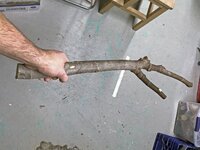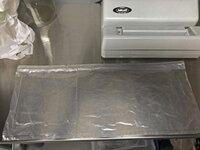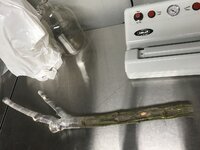figologist
Well-known member
So admittedly, I’ve become pretty excited about figs. About 4 years in and now with more than 100 varieties, it’s all I can think about. I love propagating with cuttings, grafting, but especially air layering.
Last year, I embarked on an ambitious project. I wanted to document my process for air layering an entire tree. Not just a branch - that’s easy and always works. But what if I could air layer an entire tree?
Here are the pictures to show my process - I started last July here in Oregon (zone 9a). I had a tree that I just wanted to move but didn’t want to dig it out. So I prepared the tree like any normal air layer, but on a larger scale. I removed the bark circumferentially to expose the cambium. I painted the area liberally with Clonex and let it dry. I use 80% HP Pro Mix (almost an entire bag) and 20% coarse perlite. I filled a large garbage bag with the mixture after premoistening the soil. It was a bit tricky to get the bag on - after cinching the top tight to prevent soil escape, I had to have my wife slowly cut open the side of the bag as I surrounded the denuded trunk. We used a LOT of duct tape to close the bag and then use rope like a harness to secure the bag to some of the branches to prevent slippage. I even put some 5g buckets under the bag to support the bottom of the bag.
And then the hard part - waiting. I didn’t dare touch the bag out of fear. When October/November rolled around, I peeked inside and saw nothing. Not a single root. So frustrating. I was going to just abandon the project but my wife just said to wait. So when cold weather hit, I knew it most likely wouldn’t grow much over the winter, so I surrounded the bag with a LOT of blankets and packing to keep it warm.
Luckily, we had an unseasonably mild winter here in Oregon. Last week, I looked again and saw roots. I MEAN A LOT OF ROOTS. Here’s the end result.
I’m so excited. I’m going to cut off the bottom of the root ball and then we can move this sucker to another part of the yard. I’ll use my tractor to help move it. It’s exciting to be the first person to document this feat.
My plan for future attempts is to start this process way earlier than July. Like maybe on April Fools Day.
=)
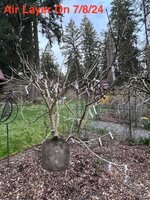
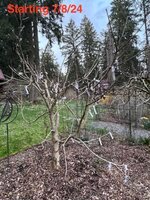
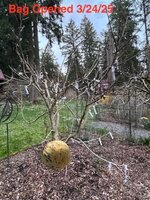
Last year, I embarked on an ambitious project. I wanted to document my process for air layering an entire tree. Not just a branch - that’s easy and always works. But what if I could air layer an entire tree?
Here are the pictures to show my process - I started last July here in Oregon (zone 9a). I had a tree that I just wanted to move but didn’t want to dig it out. So I prepared the tree like any normal air layer, but on a larger scale. I removed the bark circumferentially to expose the cambium. I painted the area liberally with Clonex and let it dry. I use 80% HP Pro Mix (almost an entire bag) and 20% coarse perlite. I filled a large garbage bag with the mixture after premoistening the soil. It was a bit tricky to get the bag on - after cinching the top tight to prevent soil escape, I had to have my wife slowly cut open the side of the bag as I surrounded the denuded trunk. We used a LOT of duct tape to close the bag and then use rope like a harness to secure the bag to some of the branches to prevent slippage. I even put some 5g buckets under the bag to support the bottom of the bag.
And then the hard part - waiting. I didn’t dare touch the bag out of fear. When October/November rolled around, I peeked inside and saw nothing. Not a single root. So frustrating. I was going to just abandon the project but my wife just said to wait. So when cold weather hit, I knew it most likely wouldn’t grow much over the winter, so I surrounded the bag with a LOT of blankets and packing to keep it warm.
Luckily, we had an unseasonably mild winter here in Oregon. Last week, I looked again and saw roots. I MEAN A LOT OF ROOTS. Here’s the end result.
I’m so excited. I’m going to cut off the bottom of the root ball and then we can move this sucker to another part of the yard. I’ll use my tractor to help move it. It’s exciting to be the first person to document this feat.
My plan for future attempts is to start this process way earlier than July. Like maybe on April Fools Day.
=)




